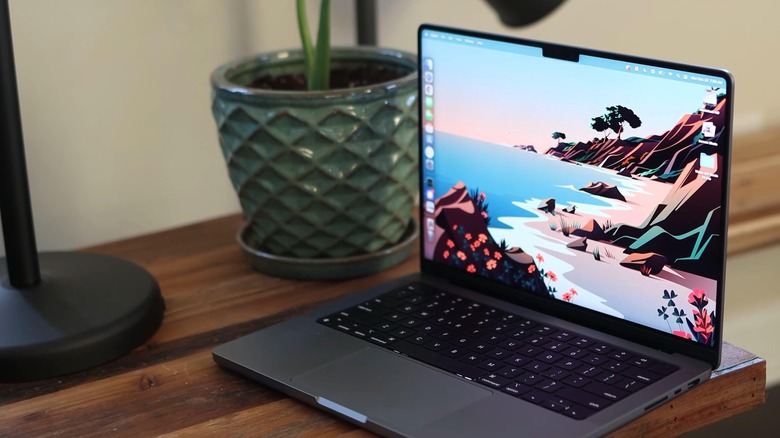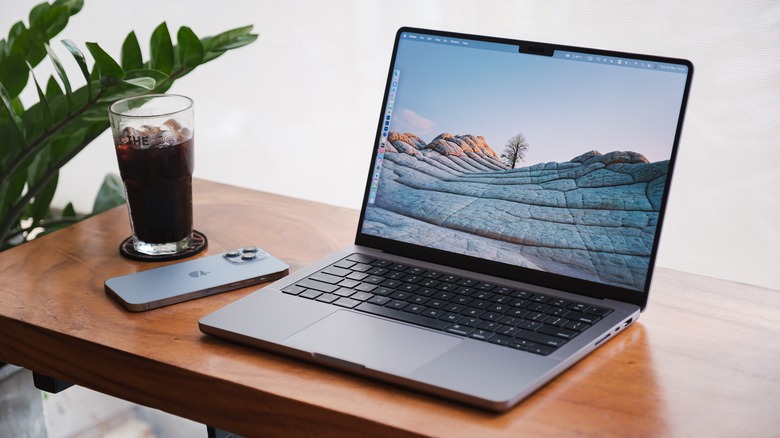How To Factory Reset Your MacBook Before You Sell It
With Apple releasing incredible tech every year, it's no wonder why you would want to upgrade your MacBook, even if yours is still working pretty well. Thankfully, the second-hand market for used MacBooks is pretty good. Because of Apple's strong branding and ecosystem, you're likely to still get a good price for your Mac, even if it's an older model — although, it's important to remember that your second-hand MacBook's value will still depend on its model, specs, and cosmetic condition.
However, before you can send your old MacBook off to serve another person, there are still a few things that you should do to keep you and your personal information safe. One of the quickest ways to make sure that no one else gets access to your online accounts, old files, banking info, and similar is to perform a factory reset, which is something you can do yourself at home in just a few minutes.
What happens when you factory reset your MacBook?
With a factory reset, you essentially wipe the MacBook's drive clean so that it is restored to its fresh-out-of-the-box state. By doing this, you can help breathe new life into your aging device and give its new owner the opportunity to start with a clean slate. In addition — and more importantly — you can be sure that none of your data can be accessed by your MacBook's next owner.
Keep in mind that the steps necessary to factory reset a MacBook vary slightly depending on whether the model you own uses Apple Silicon or Intel hardware. Here's how you can know what type of Mac you own.
- Turn on the MacBook and sign in if necessary.
- In the upper-left corner of the screen, select the Apple icon.
- Click About This Mac.
- Under Overview, check the Chip section.
Once you have determined whether your Mac has Intel or Apple hardware (such as the M1 chip), you can follow the steps below to factory reset your particular MacBook model.
How to factory reset an Intel MacBook
If you're planning to sell your Intel-based Mac, Apple recommends that you take multiple steps to prepare your MacBook for its next owner. First, it is best to back up your files, which you can do with iCloud. Second, it's important to sign out of all of your linked accounts, which include iTunes, iMessage, and iCloud, followed by wiping the hardware and resetting the NVRAM:
- Sign out of your iTunes account: click Account > Authorizations > Deauthorize This Computer. Then, key in your Apple ID login details before clicking Deauthorize.
- Remove access to iMessage: select Messages > Preferences > iMessage > Sign Out.
- Disable iCloud access: click the Apple icon > System Preferences > Apple ID > Overview > Sign Out to confirm your decision.
- Unpair Bluetooth hardware: click the Apple icon > System Preferences > Bluetooth and select "X" next to all of the paired device names.
- Erase and reinstall macOS: restart the MacBook and immediately press and hold Command + R. Then, log in to your admin account and click Disk Utility > Macintosh HD > Erase.
- Reset the NVRAM: restart the MacBook, then press Option + Command + P + R for about 20 seconds immediately once the device turns on.
These steps are fairly long compared to the process that takes place on newer MacBooks, but each step is simple and you should be sure to follow through with the process. Failing to wipe your MacBook before giving it away or selling it could leave your accounts, photos, messages, and other sensitive information accessible by whoever gets ahold of the laptop next.
How to factory reset a MacBook with Apple Silicon or T2 security chip
If you've purchased a MacBook that features Apple Silicon or an Intel-based model that sports the T2 security chip, you're in luck. In 2021, Apple released the Erase Assistant tool, which you can use to factory reset these particular MacBook models. How exactly does Erase Assistant work? The tool signs you out of Apple Services, unlinks the device from your profile on the Find My app, and erases everything from your volumes, such as your user accounts and their corresponding data. If you used Boot Camp Assistant, keep in mind that Erase Assistant will also wipe your Windows data, so be sure to backup all of your files before proceeding.
If you're ready to use Erase Assistant to wipe your MacBook, follow these steps:
- Turn on the MacBook and sign in if necessary.
- In the upper-left corner of the screen, select the Apple icon.
- Select System Preferences.
- In the menu bar, click System Preferences.
- In the drop-down bar, select Erase All Content and Settings.
- In the pop-up that appears, log in with your administrator credentials.
- Review which data on the MacBook you want to remove.
- In the lower-right corner of the screen, select Continue.
- Follow the steps on the screen.
Afterward, your MacBook will prompt you to create a Time Machine backup before confirming your decision. Then, you will be asked to sign in with your Apple ID to confirm your decision. Once the process is completed, your MacBook will be ready for its new owner.



